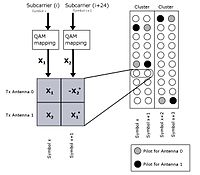Space–time code

Okay, so imagine you're playing catch with a friend. When you throw the ball, you're sending a signal to your friend -- catch this! But sometimes the signal gets mixed up and your friend drops the ball.
Now imagine you have a way to send multiple signals at the same time, and your friend is able to receive all of them. He has a better chance of catching the ball because he has more information.
That's kind of like what space-time codes do. They allow multiple signals to be sent at the same time, and the receiver can use all of the information to pick up the right signal.
But in space, things are a lot more complicated than playing catch. With space-time codes, the signals are sent using radio waves, and they can bounce off objects and get mixed up. The codes help make sure the signals aren't too mixed up, and the receiver can still understand what they mean.
It's kind of like having a special code language that only you and your friend understand. Even if there's a lot of noise or people talking around you, you can still use the code to communicate clearly.
So that's what space-time codes are all about: using special codes to make sure signals don't get mixed up in space.
Now imagine you have a way to send multiple signals at the same time, and your friend is able to receive all of them. He has a better chance of catching the ball because he has more information.
That's kind of like what space-time codes do. They allow multiple signals to be sent at the same time, and the receiver can use all of the information to pick up the right signal.
But in space, things are a lot more complicated than playing catch. With space-time codes, the signals are sent using radio waves, and they can bounce off objects and get mixed up. The codes help make sure the signals aren't too mixed up, and the receiver can still understand what they mean.
It's kind of like having a special code language that only you and your friend understand. Even if there's a lot of noise or people talking around you, you can still use the code to communicate clearly.
So that's what space-time codes are all about: using special codes to make sure signals don't get mixed up in space.
Related topics others have asked about:
